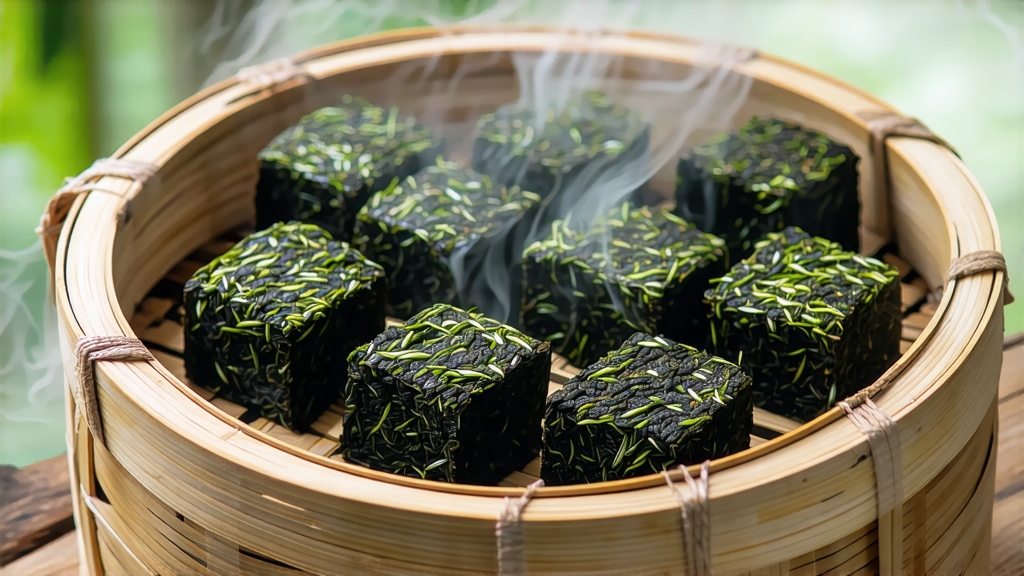
Tucked away in the humid, camphor-scented folds of southern China’s Guangxi Zhuang Autonomous Region, Liu Bao tea has spent four centuries quietly perfecting the art of subtlety. To the casual observer it is merely another dark brick, but to the initiated it is liquid history—an edible archive of mountain mists, horse caravans, and the slow dialogue between leaf, microbe, and time. While Pu-erh has become the global shorthand for Chinese post-fermented tea, Liu Bao remains the genre’s best-kept secret, a tea whose gentle earthiness and medicinal sweetness once fueled the laborers of the ancient Tea-Horse Road and still anchors the dim-sum tables of Guangdong today.
The story begins in the small county of Cangwu, Wuzhou prefecture, where the sinuous Wu River meets the Xi Jiang system that drains into the Pearl River Delta. During the Ming dynasty (1368-1644) this watery artery turned Wuzhou into a commercial choke point; Yunnan’s compressed teas, bound for Hong Kong and Southeast Asia, were off-loaded, re-packed, and re-routed. Local tea makers seized the opportunity to imitate the dark teas passing through, but they had neither Yunnan’s large-leaf cultivars nor its high-altitude sun. What they possessed was a unique terroir—low hills of lateritic red soil, subtropical humidity hovering at 80 %, and the year-round perfume of camphor and cinnamon trees. The result was Liu Bao, a tea whose very name simply means “Six Forts,” a reference to the old garrison settlements that once protected the mountain passes.
Botanically, Liu Bao is produced from a medium-leaf strain of Camellia sinensis var. sinensis locally called “medium-small leaf” (zhong xiao ye). The bushes grow scattered beneath a high canopy of evergreen forest, a polyculture that tempers sunlight and bathes the leaves in volatile terpenes from neighboring aromatic trees. Farmers typically keep the plants at waist height, pruning them into rounded umbrellas that can be plucked without ladders. Three harvests are made each year—spring, summer, and autumn—but only the spring pick is deemed worthy of long aging. The leaf is judged ready when it has grown to the width of an old Chinese coin, a tactile benchmark still invoked by elderly pickers who refuse rulers.
Processing begins within minutes of plucking. The leaves are first withered on large bamboo trays set out in the shade of the camphor canopy; the goal is to lose about 10 % moisture while allowing the ambient forest aromatics to settle on the leaf surface. Once pliable, the tea is wok-fired at 280 °C for three to four minutes, a step that arrests oxidation but preserves the leaf’s greenish core. Rolling follows, done on rattan mats with a rhythmic foot pressure that twists the leaf into tight curls without rupturing every cell wall—an important nuance that leaves microscopic channels for microbes to colonize later. After rolling, the tea is given a brief second drying, then piled 40 cm deep in a humid room for “wet piling” (wo dui), the same microbial fermentation that distinguishes all Chinese black (post-fermented) teas. In Liu Bao, however, the pile is covered not with jute but with fresh banana leaves, whose waxy surface moderates temperature and imparts a faint fruity note. For ten days the pile is turned every 24 hours; thermometers are never used—instead, the master inserts a thin bamboo pole, withdraws it, and smells: the scent should move from grassy to hay-like to the unmistakable aroma of damp forest floor after rain. When the pole smells like “mushrooms and old books,” the pile is broken down and the tea sun-dried on courtyards of polished river stones that radiate gentle heat even after sunset.
The final, defining touch is the bamboo basket aging. The fermented tea is steamed for 30 seconds, then packed by hand into cylindrical baskets woven from two-year-old mao zhu bamboo. Each basket holds exactly 50 kg; workers tramp the tea with their bare feet, a dance that compresses the leaf just enough to slow oxygen exchange while still allowing micro-crevices for continued fermentation. The baskets are then stacked in riverside warehouses whose walls are black with decades of fungal spores. Here, the tea will rest for a minimum of three years, often for thirty. Over time the camphor vap